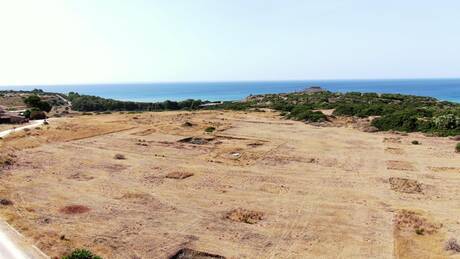An agora of almost 33 thousand square meters, the largest in the ancient world
, which returns to show its boundaries.
And then again, on the acropolis, the remains of what appears to have been the sacred place of the very first Greek settlers of Selinunte, who arrived in the wake of the founder Pammilo from Megara Hyblea.
But also amulets and objects of great refinement equal to others found in Greece, in Delphi, which add to the mystery of a stone mold perhaps used to melt a bronze scepter.
These are the discoveries - which ANSA publishes in preview - of the latest excavation campaign led by Clemente Marconi in the Sicilian archaeological park,
an undertaking that saw two international missions working together for the first time, that of the Institute of Fine Arts of New York University and of the University of Milan with the team of the Germanic Archaeological Institute.
The scepter and the siren, new light on the ancient Selinunte
"Results of the utmost importance for the knowledge of Selinunte in the archaic and classical age",
underlines Marconi, the archaeologist who has been studying the remains of the ancient Greek colony for decades.
Discoveries that illuminate a new light on the fascinating and brief history of this city and that are announced while in the Sicilian park - the largest in Europe with its 270 hectares of nature and majestic ruins overlooking the sea - an intervention on the vegetation studied by Istituto Germanico has just brought to light the boundaries of the agora, with its enormous dimensions (double the size of Piazza del Popolo in Rome) and the vaguely trapezoidal shape with a single monument in the center, a tomb, perhaps that of the founder.
“An empty basin that impresses with its width and its dense mystery”, smiles the director of the Archaeological Park of Selinunte, Felice Crescente.
A space "that gives the idea of the magnificence of this city and its extraordinary essence", comments the councilor for culture Alberto Samonà next to him.
After two years slowed down by the pandemic, in June the digging resumed at full speed and the results, Marconi underlines, "went far beyond expectations".
The starting idea was to be able to date the construction period of two of the most recent temples of the acropolis, called A and O, long considered twins.
The excavation showed that A was built before O and that the construction of the latter was probably interrupted due to a landslide.
The most important discovery, however, was that of a water fault under the foundations of temple A,
a detail, the professor points out, "which confirms the hypothesis that the first Greek colonists settled in this southern portion of the Acropolis".
In short, it is here that the ancient Selinus was born.
Selinunte: an image of the excavation in the foundations of temple A on the acropolis.
The presence of water is proof that the very first settlers settled here.
Not only.
Because digging deep around a third temple, the so-called R, built in the sixth century.
BC and then perhaps rebuilt after 409 BC when the Carthaginians occupied and destroyed the city, archaeologists have identified the walls of a ritual enclosure dating back to 610 BC, not long after the arrival of the colonists led by Pammilo , which Thucydides fixes to 628 BC and Diodorus to 650 BC.
C. And it is also here, inside the temple R, that the earth has returned the missing part of a stone matrix (the first was found ten years ago at a short distance) used for the casting of a bronze object, it looks like one scepter.
An object so precious, archaeologists now speculate, that it does not have to be replicated.
For this reason, immediately after the fusion, the matrices would have been buried in two different places.
The stone matrix for the construction of a metal scepter found in the excavations around the temple R.
From that same building, Marconi reveals, two objects arrive, which in the next few days will be exhibited in the Park's antiquarium: an amulet in the shape of a hawk, an image of the sky god Horus made in Egyptian blue, which comes from Egypt at the end. of the seventh century.
a C, and a very refined miniature figurine of an ivory mermaid, found in fragments in 2017 and rebuilt in recent months in the laboratory.
A small wonder, Marconi points out, almost certainly imported from Greece, which "tells of the wealth achieved by the city in the sixth century BC".
Two centuries later the end for Selinunte will be terrible, with the city set on fire by Hannibal's soldiers.
Buried for centuries, the grandeur of that golden age returns today to amaze.

